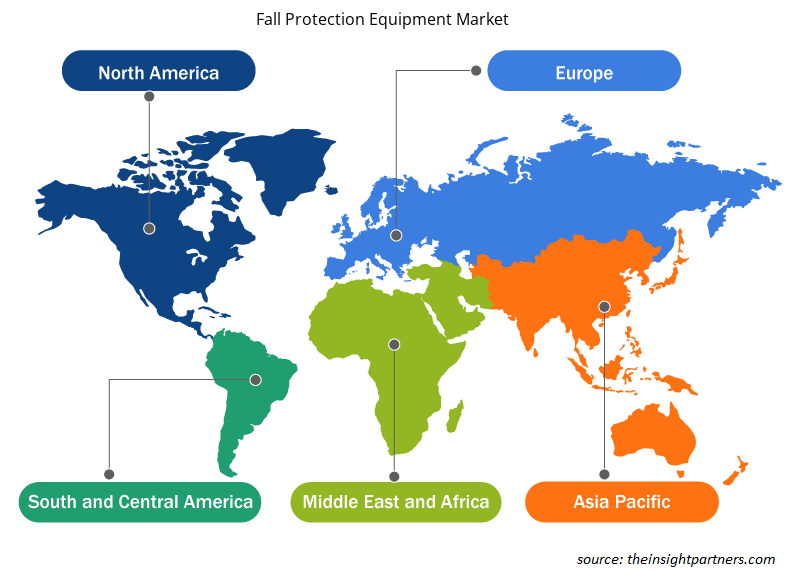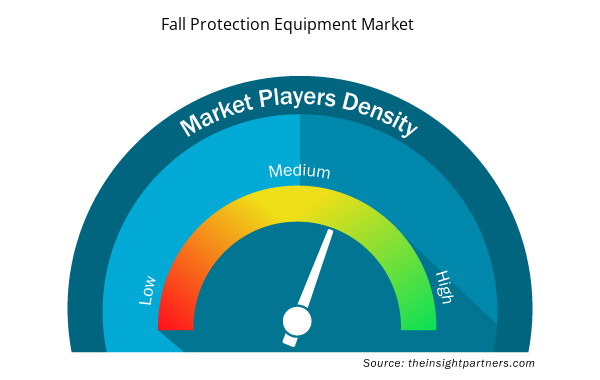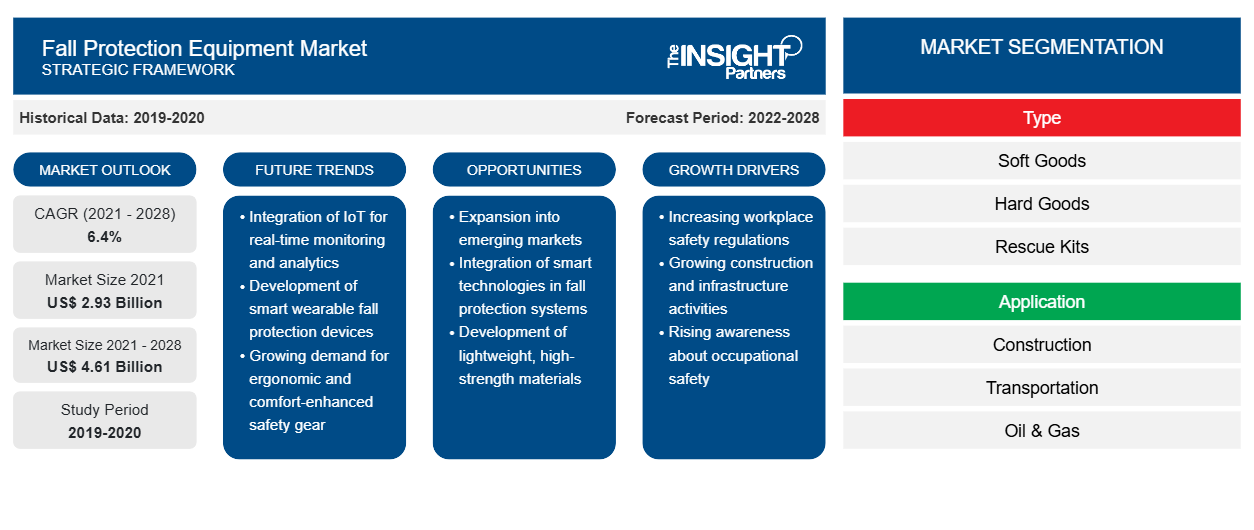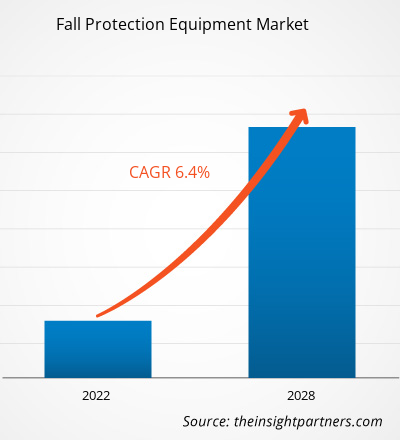Se espera que el mercado de equipos de protección contra caídas crezca de US$ 2.934,86 millones en 2021 a US$ 4.606,61 millones en 2028; se estima que crecerá a una CAGR del 6,4% durante 2021-2028.
La rápida industrialización en los países desarrollados y en desarrollo es uno de los principales factores que impulsan la expansión del mercado. Los riesgos laborales son cada vez más frecuentes debido a la falta de procedimientos de seguridad adecuados en diversas plantas de fabricación, minería y otras plantas industriales. En comparación con otros países, Estados Unidos está más preocupado por la seguridad y la salud de sus trabajadores, lo que está impulsando la adopción de equipos de protección contra caídas en el país. Para supervisar las normas y procedimientos de seguridad, el país ha establecido ciertas autoridades como la Administración de Seguridad y Salud Ocupacional (OSHA) y el Instituto Nacional Estadounidense de Normas (ANSI). La OSHA es una organización de cumplimiento y normas de salud y seguridad que brinda a los trabajadores capacitación de concienciación de 10 y 30 horas sobre las normas y estándares de la OSHA relevantes para diversas vocaciones en el lugar de trabajo. Sin embargo, el creciente enfoque en las prácticas de seguridad en el trabajo y la mejora de las regulaciones gubernamentales para la seguridad de los trabajadores en Europa y Asia han impulsado el mercado. Se espera que el aumento de las actividades de construcción y el creciente sector del petróleo y el gas en países asiáticos como India y China, debido al aumento de la población, impulsen el crecimiento del mercado durante el período de pronóstico. El aumento de la urbanización y el crecimiento de la industria del petróleo y el gas se encuentran entre los factores clave que respaldan el crecimiento del mercado de equipos de protección contra caídas en las regiones MEA (Medio Oriente y África) y SAM (América del Sur).
Personalice este informe según sus necesidades
Obtendrá personalización en cualquier informe, sin cargo, incluidas partes de este informe o análisis a nivel de país, paquete de datos de Excel, así como también grandes ofertas y descuentos para empresas emergentes y universidades.
- Obtenga las principales tendencias clave del mercado de este informe.Esta muestra GRATUITA incluirá análisis de datos, desde tendencias del mercado hasta estimaciones y pronósticos.
Impacto de la pandemia de COVID-19 en el mercado de equipos de protección contra caídas
El brote de COVID-19 ha continuado sus efectos adversos en varios países también en 2021. El cierre de las plantas de producción o las operaciones comerciales limitadas y los confinamientos y las limitaciones de viaje han obstaculizado la producción y la cadena de suministro de equipos de protección contra caídas. La demanda constante de equipos de protección contra caídas experimentó una ligera disminución en 2020, debido al confinamiento impuesto por el gobierno y al bajo número de proyectos de construcción. Sin embargo, en 2021, debido al aumento de las actividades de construcción, la exploración de petróleo y gas y los proyectos de telecomunicaciones, existe una demanda de equipos de protección contra caídas para garantizar la seguridad de los empleados. Las empresas de comercio electrónico también han contribuido a impulsar la necesidad de equipos de protección contra caídas en el sector de la construcción.
Perspectivas del mercado de equipos de protección contra caídas
Aumento de las actividades de construcción
El aumento de las actividades de construcción en todo el mundo es un elemento fundamental que impulsa el mercado de equipos de protección contra caídas. Mientras que países asiáticos como India y China están experimentando un importante crecimiento demográfico, la demanda de espacios comerciales y residenciales en estos países está en constante expansión. La economía mundial está experimentando actualmente una desaceleración severa debido a una creciente restricción crediticia que está haciendo que las economías de todo el mundo no alcancen sus ambiciones de desarrollo. La infraestructura sigue siendo una prioridad importante para abordar las brechas de desarrollo en el escenario actual, ya que se la considera omnipotente y capaz de sacar a las economías de la convulsión financiera. Los gobiernos de todo el mundo están invirtiendo dinero en infraestructura física y social para aumentar la demanda de productos y servicios mediante la creación de puestos de trabajo.
Perspectivas del mercado basadas en tipos
Según el tipo, el mercado de equipos de protección contra caídas se segmenta en productos blandos, productos duros, kits de rescate, cinturones corporales, arneses de cuerpo completo y otros. El segmento de productos duros es el segmento líder, ya que ofrece mayor seguridad. Además, se supone que la creciente innovación en este segmento impulsará el crecimiento del mercado. Sin embargo, la creciente demanda de sistemas de arneses de cuerpo completo por parte de todos los usuarios industriales está ayudando a que el segmento crezca a la CAGR más alta.
Perspectivas de mercado basadas en aplicaciones
En términos de aplicación, el mercado de equipos de protección contra caídas se divide en construcción, petróleo y gas, transporte, energía y servicios públicos, y telecomunicaciones. Para garantizar el flujo eficaz de actividades y mantener la seguridad de los trabajadores, cada industria requiere equipos de protección contra caídas en sus instalaciones. En 2020, el segmento de la construcción representó la mayor participación de mercado.
Los actores que operan en el mercado de equipos de protección contra caídas adoptan estrategias como fusiones, adquisiciones e iniciativas de mercado para mantener sus posiciones en el mercado. A continuación, se enumeran algunos de los desarrollos de los actores clave:
- En mayo de 2021, Pure Safety Group incorporó su familia de marcas de seguridad en altura (Stronghold by PSG, Ty-Flt, Checkmate y HART) a la marca Guardian. Esta expansión ha convertido a Guardian en la marca independiente de prevención y protección contra caídas más grande del mundo.
- 3M Fall Protection inventó e incluyó correas de seguridad contra traumatismos por suspensión en todos los arneses 3M DBI SALA con certificación ANSI y CSA a fines de marzo de 2021.
Perspectivas regionales del mercado de equipos de protección contra caídas
Los analistas de Insight Partners explicaron en detalle las tendencias y los factores regionales que influyen en el mercado de equipos de protección contra caídas durante el período de pronóstico. Esta sección también analiza los segmentos y la geografía del mercado de equipos de protección contra caídas en América del Norte, Europa, Asia Pacífico, Oriente Medio y África, y América del Sur y Central.

- Obtenga datos regionales específicos para el mercado de equipos de protección contra caídas
Alcance del informe de mercado de equipos de protección contra caídas
| Atributo del informe | Detalles |
|---|---|
| Tamaño del mercado en 2021 | US$ 2.93 mil millones |
| Tamaño del mercado en 2028 | US$ 4.61 mil millones |
| CAGR global (2021-2028) | 6,4% |
| Datos históricos | 2019-2020 |
| Período de pronóstico | 2022-2028 |
| Segmentos cubiertos | Por tipo
|
| Regiones y países cubiertos | América del norte
|
| Líderes del mercado y perfiles de empresas clave |
|
Densidad de actores del mercado: comprensión de su impacto en la dinámica empresarial
El mercado de equipos de protección contra caídas está creciendo rápidamente, impulsado por la creciente demanda de los usuarios finales debido a factores como la evolución de las preferencias de los consumidores, los avances tecnológicos y una mayor conciencia de los beneficios del producto. A medida que aumenta la demanda, las empresas amplían sus ofertas, innovan para satisfacer las necesidades de los consumidores y aprovechan las tendencias emergentes, lo que impulsa aún más el crecimiento del mercado.
La densidad de actores del mercado se refiere a la distribución de las empresas o firmas que operan dentro de un mercado o industria en particular. Indica cuántos competidores (actores del mercado) están presentes en un espacio de mercado determinado en relación con su tamaño o valor total de mercado.
Las principales empresas que operan en el mercado de equipos de protección contra caídas son:
- 3M
- Tecnología de caída
- Producción de French Creek
- Primera línea
- Protección contra caídas Guardian
Descargo de responsabilidad : Las empresas enumeradas anteriormente no están clasificadas en ningún orden particular.

- Obtenga una descripción general de los principales actores clave del mercado de equipos de protección contra caídas
El mercado mundial de equipos de protección contra caídas se ha segmentado como se menciona a continuación:
Por tipo
- Bienes blandos
- Bienes duros
- Kits de rescate
- Cinturones corporales
- Arnés de cuerpo completo
- Otros
Por aplicación
- Construcción
- Transporte
- Petróleo y gas
- Minería
- Energía y servicios públicos
- Telecomunicaciones
- Otros
Por geografía
América del norte
- A NOSOTROS
- Canadá
- México
Europa
- Francia
- Alemania
- Italia
- Reino Unido
- Rusia
- Resto de Europa
Asia Pacífico (APAC)
- Porcelana
- India
- Corea del Sur
- Japón
- Australia
- Resto de APAC
Oriente Medio y África (MEA)
- Sudáfrica
- Arabia Saudita
- Emiratos Árabes Unidos
- Resto de MEA
América del Sur (SAM)
- Brasil
- Argentina
- Resto de SAM
Perfiles de empresas
- 3M
- Tecnología de caída
- Producción de French Creek
- Primera línea
- Protección contra caídas Guardian
- Seguridad de Kee
- Seguridad Kwik
- Seguridad MSA Incorporada
- Compañía: Honeywell International Inc.
- Protección contra caídas Tritech
- Análisis histórico (2 años), año base, pronóstico (7 años) con CAGR
- Análisis PEST y FODA
- Tamaño del mercado Valor/volumen: global, regional, nacional
- Industria y panorama competitivo
- Conjunto de datos de Excel



Report Coverage
Revenue forecast, Company Analysis, Industry landscape, Growth factors, and Trends

Segment Covered
This text is related
to segments covered.

Regional Scope
North America, Europe, Asia Pacific, Middle East & Africa, South & Central America

Country Scope
This text is related
to country scope.
Preguntas frecuentes
3M; Falltech; French Creek Production; Frontline; Gravitec Systems, Inc.; Guardian Fall (Pure Safety Group, Inc.); Honeywell International Inc; Kwiksafety; Kee Safety, Inc; and Msa are the key companies in the fall protection equipment market.
APAC led the global fall protection equipment market with the highest growth rate in 2020, followed by North America and Europe. In the coming years, the market in Asia would witness a massive growth in demand for fall protection equipment, owing to the rise in population of countries in the region, coupled with various government initiatives to attract private investments in construction and infrastructure development. Moreover, the surging number of commercial and industrial end users is inclined to use fall protection equipment to keep their workers safe from hazards.
The construction segment led the fall protection equipment market globally with a highest market share in the year 2020 and is expected to continue its dominance during the forecast period till 2028. The construction sector is the most common end user of fall prevention systems, as it has the highest annual injury rate. The global construction sector is responsible for more than a third of all workplace deaths each year. Due to a large number of planned building projects, the US is one of the most important countries for safety equipment on construction sites. As mandated by administrations in several states across the US, the use of fall protection systems to reduce the number of accidents and fatalities during building activities is expected to fuel the growth of this market. The US country is one of the major construction industry markets, with a spending worth of ~1.5 trillion in June 2021. Recent advancements in construction technologies and rising demand for worker safety solutions have driven the market growth. However, the shutdown of construction projects and delayed residential projects investments due to the COVID - 19 pandemic has severely impacted the market growth as the demand for fall protection equipment has been lowered.
The fall protection equipment market by product type was led by hard goods which held a market share of 36.8% in the year 2020 and is anticipated to continue its dominance during the forecast period to account for 37.8% share of the fall protection equipment market by the year 2028. The development of hard good (those made from metal or other non-synthetic materials) fall equipment is focused on adaptability and efficiency. Anchors, carabiners, rope grabs, and retractable blocks are examples of hard goods. Anchors are extremely capable of supporting intended weights and assisting in the prevention of falls. The use of hard goods is important in the mining sector since it increases worker flexibility and convenience. The growth of the mining sector in the US is expected to boost the demand for these products. Rope grabs are the ideal alternative for vertical and horizontal lifeline systems used in construction and mining industries because they enable level and inertial locking to prevent the fall. Today's hard goods have various capacities, and they reduce the amount of equipment required at the workplace. Self-retracting lifelines with a built-in rescue system are a newer addition. Depending on the surroundings, these devices, which may be programmed to automatically lower a worker in the event of a fall, can obviate the need for a separate rescue system on site.
With the rising speed and progress of structure and building design, the problems and hazards associated with it are also increasing. To maintain safety requirements, the safety equipment must also be upgraded over time. As a result of changing patterns, governments across the world have revised their fall protection requirements. Current fall prevention equipment has undergone adjustments as a result of the revised standard. The standard mandates that gate strength requirements for snap hooks and carabiners be doubled to 3,600 pounds in all directions of possible loading. The old ANSI standard demanded 220 pounds on the gate's face and 350 pounds on the gate's side, even though many manufacturers were already fulfilling the new standard's criteria when it was approved. To optimize fall arrest, harnesses must now include D-rings in the front and rear, and twin-leg lanyards must be tested before use and have cautions on product labels on how to use them appropriately. As a result, fall protection equipment suppliers will see creating adjustable fall protection equipment as a prime opportunity.
The rise in construction activities around the world is a primary element driving the fall protection equipment market. As Asian countries such as India and China are witnessing significant population growth, the demand for commercial and residential spaces in these countries is constantly expanding. The global economy is currently experiencing a severe slowdown due to a developing credit constraint that is causing economies around the world to miss their developmental ambitions. Infrastructure remains a major priority for addressing developmental gaps in the current scenario, as it is seen as omnipotent and capable of bringing economies out of financial upheaval. Governments all over the world are pumping money into physical and social infrastructure to increase the demand for products and services by creating jobs. During COVID, Construction is more important than ever in this difficult time. The sector has played a crucial role in responding to the crisis and in the recovery, from erecting hospitals in a matter of days to giving lifesaving equipment. The construction industry accounts for 13% of global GDP, and the increasing worker availability could assist recovery while tackling the most pressing issues. Despite challenges in 2020, the oil industry is finally starting to recover. As a consequence, the economy is boosting. The aforementioned factors are expected to fuel the need for fall protection equipment worldwide.
Trends and growth analysis reports related to Manufacturing and Construction : READ MORE..
The List of companies - Fall Protection Equipment Market
- 3M
- Falltech
- French Creek Production
- Frontline
- Guardian Fall Protection
- Kee Safety
- KwikSafety
- MSA Safety Incorporated
- Honeywell International Inc.
- Tritech Fall Protection
The Insight Partners performs research in 4 major stages: Data Collection & Secondary Research, Primary Research, Data Analysis and Data Triangulation & Final Review.
- Data Collection and Secondary Research:
As a market research and consulting firm operating from a decade, we have published and advised several client across the globe. First step for any study will start with an assessment of currently available data and insights from existing reports. Further, historical and current market information is collected from Investor Presentations, Annual Reports, SEC Filings, etc., and other information related to company’s performance and market positioning are gathered from Paid Databases (Factiva, Hoovers, and Reuters) and various other publications available in public domain.
Several associations trade associates, technical forums, institutes, societies and organization are accessed to gain technical as well as market related insights through their publications such as research papers, blogs and press releases related to the studies are referred to get cues about the market. Further, white papers, journals, magazines, and other news articles published in last 3 years are scrutinized and analyzed to understand the current market trends.
- Primary Research:
The primarily interview analysis comprise of data obtained from industry participants interview and answers to survey questions gathered by in-house primary team.
For primary research, interviews are conducted with industry experts/CEOs/Marketing Managers/VPs/Subject Matter Experts from both demand and supply side to get a 360-degree view of the market. The primary team conducts several interviews based on the complexity of the markets to understand the various market trends and dynamics which makes research more credible and precise.
A typical research interview fulfils the following functions:
- Provides first-hand information on the market size, market trends, growth trends, competitive landscape, and outlook
- Validates and strengthens in-house secondary research findings
- Develops the analysis team’s expertise and market understanding
Primary research involves email interactions and telephone interviews for each market, category, segment, and sub-segment across geographies. The participants who typically take part in such a process include, but are not limited to:
- Industry participants: VPs, business development managers, market intelligence managers and national sales managers
- Outside experts: Valuation experts, research analysts and key opinion leaders specializing in the electronics and semiconductor industry.
Below is the breakup of our primary respondents by company, designation, and region:

Once we receive the confirmation from primary research sources or primary respondents, we finalize the base year market estimation and forecast the data as per the macroeconomic and microeconomic factors assessed during data collection.
- Data Analysis:
Once data is validated through both secondary as well as primary respondents, we finalize the market estimations by hypothesis formulation and factor analysis at regional and country level.
- Macro-Economic Factor Analysis:
We analyse macroeconomic indicators such the gross domestic product (GDP), increase in the demand for goods and services across industries, technological advancement, regional economic growth, governmental policies, the influence of COVID-19, PEST analysis, and other aspects. This analysis aids in setting benchmarks for various nations/regions and approximating market splits. Additionally, the general trend of the aforementioned components aid in determining the market's development possibilities.
- Country Level Data:
Various factors that are especially aligned to the country are taken into account to determine the market size for a certain area and country, including the presence of vendors, such as headquarters and offices, the country's GDP, demand patterns, and industry growth. To comprehend the market dynamics for the nation, a number of growth variables, inhibitors, application areas, and current market trends are researched. The aforementioned elements aid in determining the country's overall market's growth potential.
- Company Profile:
The “Table of Contents” is formulated by listing and analyzing more than 25 - 30 companies operating in the market ecosystem across geographies. However, we profile only 10 companies as a standard practice in our syndicate reports. These 10 companies comprise leading, emerging, and regional players. Nonetheless, our analysis is not restricted to the 10 listed companies, we also analyze other companies present in the market to develop a holistic view and understand the prevailing trends. The “Company Profiles” section in the report covers key facts, business description, products & services, financial information, SWOT analysis, and key developments. The financial information presented is extracted from the annual reports and official documents of the publicly listed companies. Upon collecting the information for the sections of respective companies, we verify them via various primary sources and then compile the data in respective company profiles. The company level information helps us in deriving the base number as well as in forecasting the market size.
- Developing Base Number:
Aggregation of sales statistics (2020-2022) and macro-economic factor, and other secondary and primary research insights are utilized to arrive at base number and related market shares for 2022. The data gaps are identified in this step and relevant market data is analyzed, collected from paid primary interviews or databases. On finalizing the base year market size, forecasts are developed on the basis of macro-economic, industry and market growth factors and company level analysis.
- Data Triangulation and Final Review:
The market findings and base year market size calculations are validated from supply as well as demand side. Demand side validations are based on macro-economic factor analysis and benchmarks for respective regions and countries. In case of supply side validations, revenues of major companies are estimated (in case not available) based on industry benchmark, approximate number of employees, product portfolio, and primary interviews revenues are gathered. Further revenue from target product/service segment is assessed to avoid overshooting of market statistics. In case of heavy deviations between supply and demand side values, all thes steps are repeated to achieve synchronization.
We follow an iterative model, wherein we share our research findings with Subject Matter Experts (SME’s) and Key Opinion Leaders (KOLs) until consensus view of the market is not formulated – this model negates any drastic deviation in the opinions of experts. Only validated and universally acceptable research findings are quoted in our reports.
We have important check points that we use to validate our research findings – which we call – data triangulation, where we validate the information, we generate from secondary sources with primary interviews and then we re-validate with our internal data bases and Subject matter experts. This comprehensive model enables us to deliver high quality, reliable data in shortest possible time.


 Obtenga una muestra gratuita de este informe
Obtenga una muestra gratuita de este informe